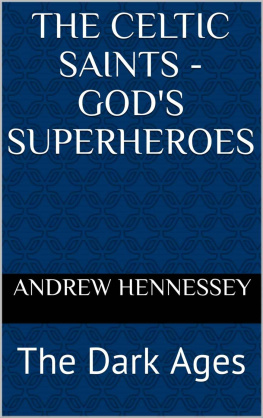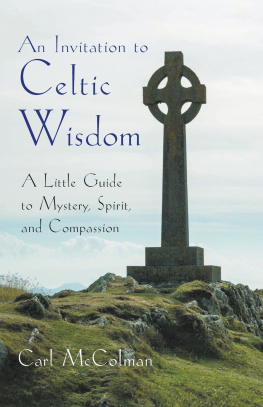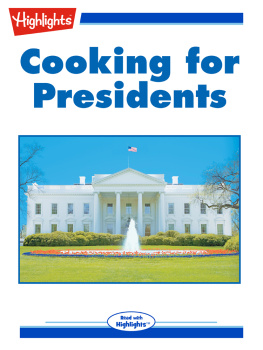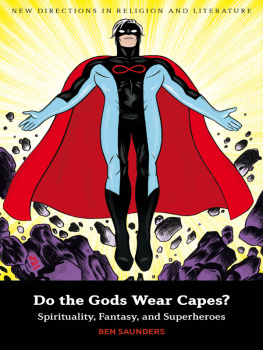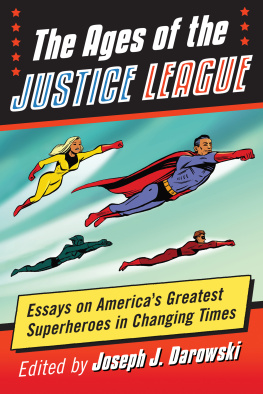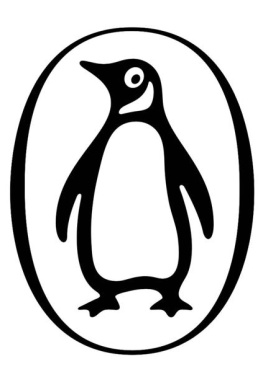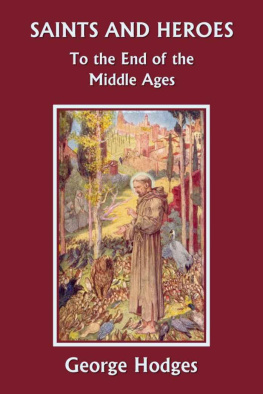Andrew Hennessey - The Celtic Saints - Gods Superheroes: The Dark Ages
Here you can read online Andrew Hennessey - The Celtic Saints - Gods Superheroes: The Dark Ages full text of the book (entire story) in english for free. Download pdf and epub, get meaning, cover and reviews about this ebook. year: 2019, genre: Art. Description of the work, (preface) as well as reviews are available. Best literature library LitArk.com created for fans of good reading and offers a wide selection of genres:
Romance novel
Science fiction
Adventure
Detective
Science
History
Home and family
Prose
Art
Politics
Computer
Non-fiction
Religion
Business
Children
Humor
Choose a favorite category and find really read worthwhile books. Enjoy immersion in the world of imagination, feel the emotions of the characters or learn something new for yourself, make an fascinating discovery.
- Book:The Celtic Saints - Gods Superheroes: The Dark Ages
- Author:
- Genre:
- Year:2019
- Rating:5 / 5
- Favourites:Add to favourites
- Your mark:
- 100
- 1
- 2
- 3
- 4
- 5
The Celtic Saints - Gods Superheroes: The Dark Ages: summary, description and annotation
We offer to read an annotation, description, summary or preface (depends on what the author of the book "The Celtic Saints - Gods Superheroes: The Dark Ages" wrote himself). If you haven't found the necessary information about the book — write in the comments, we will try to find it.
The Celtic Saints - Gods Superheroes: The Dark Ages — read online for free the complete book (whole text) full work
Below is the text of the book, divided by pages. System saving the place of the last page read, allows you to conveniently read the book "The Celtic Saints - Gods Superheroes: The Dark Ages" online for free, without having to search again every time where you left off. Put a bookmark, and you can go to the page where you finished reading at any time.
Font size:
Interval:
Bookmark:
THE CELTIC SAINTS GODS SUPERHEROES
PART 2 OF 3-PART SERIALISATION BY
ANDREW HENNESSEY

Contents
ANDREW
CHAPTER 01 A DIFFERENT SCRIPT

Photo: St Andrew, St Gervais, Rouen, France
W e are not the offspring of time, afterward to be dissolved by time; we are not a contrivance (product) of motion, made to be again destroyed by itself, nor things of earthly birth. ending again therein.
Andrew the Apostle: M. Bonnet in a Vatican MS. (Gr. 808) of tenth to eleventh century
The last time England and Scotland hooked-up and journeyed together on a pilgrimage was during the Ordovician Period about 450 Million years ago towards the end of the Palaeozoic era.
Then, in tropical times, and covered in the (oil-producing) swamps that would one day prove to be its greatest asset, Scotland and its other continental companions headed north to colder climates.
The old red sandstones that would later be quarried in central Scotland to build its capital city, Edinburgh were still part of a shallow, warm lagoon, and the sands that would become the fake Stone of Destiny at Scone, then Westminster, hadn't yet felt the pressures and squeeze of the Caledonian mountain-building process.
During that epoch - the worlds biggest mountain range (The Himalayas) emerged from the depths of its deepest (Tethys) ocean, whilst the northward migration of muddy continents seemed to leave giant fossil footprints at Paluxy river in Texas or sightings of giant hairy people in the American Ozark mountains - these localities used to be part of the ancient tropical Cimmeranian range those many millions of years ago before the continental plate it was on made the move north and west with Scotland.
Open to speculation and dependent on the fragile nature of folklore and myth, it can be said that there were giants in those days.

Photo: Poulnabrone Dolmen, Co Claire, Ireland, VanDemboomen A, pixabay.
Without looking in depth into the evidence for past and highly technological epochs from e.g. Michael Cremo's 'Forbidden Archaeology' , or looking beyond the fake surgical procedure/operating theatre native art that sullied the presentation of heroes such as Erich Von Daniken, there are strong indications from global folklore that something special - some highly technical civilisation capable of producing atomic weaponry, and Vimanas - craft that today can be seen littering Mars - lying where they fell from unhappy war-like skies many millennia ago - had ended.
What today we collectively label the Atlantean epoch had come crashing to a close.. by most accounts.
I say most accounts because there are some very obvious gatekeepers for 'established' knowledge working to control and keep humanity in the dark regarding its origins and its future.
For example; the account of the African genesis of Homosapien and the slow careful, construction of their adaptations and linear biological evolution appears to be a (well-illustrated) pantomime.
e.g. in western Europe, Homo Neanderthal and Cro-Magnon man were co-existing and there had been no gradual growth or evolution - of the more primitive into the very refined.
The Wright brothers first contraption and a stealth bomber co-existing on an airstrip, allegedly with the same reason for being there.
Humankind's self-centred sense of isolation - from the rest of the Cosmos also appears to be an externally enforced contrivance. Many can still be seen trying to chomp their way through as many remaining apples from the remaining trees of knowledge as possible attempting to recreate God's intelligence artificially in a box.
The inability of one generation to successfully compute artificial intelligence, however, is hidden from the next because many paradoxes just get renamed.
[e.g. Humes 19th Century Paradox of Induction becomes the cool-sounding 21st Century Kolmogorov Theatre Paradox !]
Given many billions of human beings on this planets surface are living and dying in worse conditions than those of the slaves of Egypt c.a. 2500 BC - Who or what made the decision to opt us out of an automatic, self-maintaining, easily supplied Utopia in the 20th and 21 st Century ?
It is as though humanity in being covered in accretions of stuff it has 'made' or put its mind to - has lost its sense of place, proportion and scale. e.g. the mega giant protozoan filmed sucking plasma from our star, or, the ecosystem of giant, adapted, oceanic-looking, magnetospheric life, feeding off the reef-like electro-magnetic Van Allen Belt in interplanetary space ought to have engendered a sense of humility not a denial of the natural order.

Photo: Courtesy of JPL and NASA, Huge anaerobic, chaotically designed (golden ratio or phi) simple creature with spiral shell.
e.g. Although not every seaside Nautilus shell spiral is created equal, nor is it created with complete perfection - the Nautilus spiral can exhibit dimensions whose proportions come close to phi, the natural constant of Fibonacci cell growth in all things that grow.
Humanity has no sense of continuity of life beyond the physical or of an eternal soul and fails to see even in its own space-garnered empirical data a stairway to heaven manifesting physically because human ego is severely limited to self-imposed comfort zone.

Photo: Courtesy NASA, Apollo8, giant anaerobic jellyfish feeding in the interplanetary Van Allen Belt an energy-infused order of life beyond Oxygen
e.g. NASA is eyeing up a nearby asteroid that contains enough gold to make everyone on Earth a billionaire.
Psyche 16 is nestled between the orbits of Mars and Jupiter and is made of solid metal.
Scott Moore, who heads up EuroSun Mining, said the sheer amount of gold in the asteroid threatens to throw the gold industry into chaos.
"The 'Titans of Gold' now control hundreds of the best-producing properties around the world," he told Oil Price. "But the 4-5 million ounces of gold they bring to the market every year pales in comparison to the conquests available in space."
Also, with private ownership legal since 2105, two companies; Deep Space Industries and Planetary Resources each have their eyes on another asteroid, the 2011 UW158, which is twice the size of the Tower of London and worth up to $5.7 trillion.
With humanity now reaching towards the heavens for the wrong reasons it has probably become necessary to drop a few hints and erect signposts towards true home for those who need them.
Cue at least the stories of miraculous and heavenly intercessions in the lives of the ancient Celtic Saints.
It may be, therefore, that it has become impossible to recognise or witness acts of seeming 'magic' or other more spontaneous manifestations of will or even further distinguish between wilful magic and Divine Providence.
For Humanity, with Its blinkered and cosseted sense of reason and perspective, is currently, unfortunately, far above the possibility that even pondlife can easily survive earth - by breathing electrons in interplanetary space.
Next pageFont size:
Interval:
Bookmark:
Similar books «The Celtic Saints - Gods Superheroes: The Dark Ages»
Look at similar books to The Celtic Saints - Gods Superheroes: The Dark Ages. We have selected literature similar in name and meaning in the hope of providing readers with more options to find new, interesting, not yet read works.
Discussion, reviews of the book The Celtic Saints - Gods Superheroes: The Dark Ages and just readers' own opinions. Leave your comments, write what you think about the work, its meaning or the main characters. Specify what exactly you liked and what you didn't like, and why you think so.

